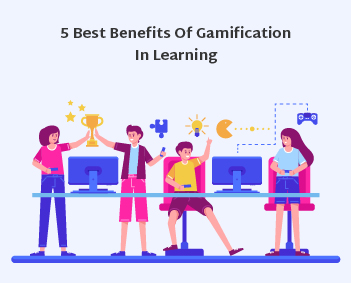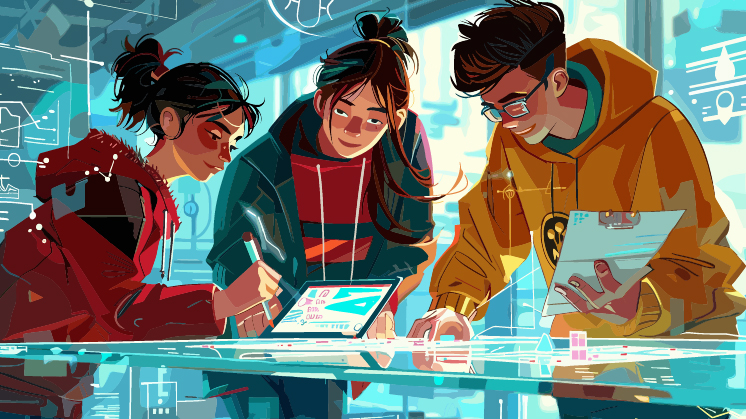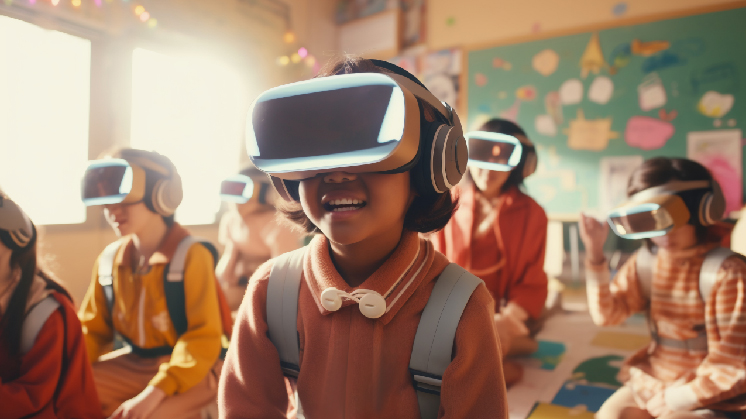For many students, studying and gaming appear as two distinct activities: learning occurs in the classroom, while gaming occurs during free time. However, the two can work remarkably well together in the form of game-based learning. Nowadays, a lot of educators are adopting the concept of gamification in learning. They are incorporating gamification techniques for learning lessons, such as points, rewards, and leaderboards.

By incorporating game mechanics in education, educators can observe the benefits of gamification in learning through enthusiasm and innovative learning methods.
How Gamification in Learning Motivates Learners
Why would 22 individuals gather to bounce a ball around on a cold, muddy field on a wet February day? There are two main reasons why football is one of the best pastimes in the world. First of all, its simplicity makes it accessible to nearly everyone, and second, it is driven by the desire to succeed.
If that goal were removed, the game would suddenly become redundant. Baseball, hockey, rugby, football, and all other competitive sports depend on the spirit of competition to draw large crowds.
Gamification in learning is the outcome of applying this “motivating factor” to education.
Gamification in Learning: How to Gamify a Lesson
- Make ‘no-brainer’ learning outcomes
- Design a gamified structure with a clear points and rewards system
- Record and share the achievements of the learners
It should come as no surprise that children, teenagers, and adults love to play games. These diversions massively influence people’s lives, whether they are video games, board games, tag, or brand-new games created by classmates.
Teachers can increase student engagement in learning by employing the thrill of games in the classroom.
The first step in incorporating gamification in learning is to start with the learning objectives. When creating enjoyable and personalized learning via gamification, it’s simple to lose focus on your goals. “How does this help students obtain the learning objectives?” is a question you should keep asking yourself.
Next is the actual game structure, which might vary according to the topic matter and the group of students’ personalities. Points, badges, and levels to unlock a leaderboard are typical learning elements through play. It can take the form of a game show to review a subject, a simulation to immerse students, or a menu with various point values that students can select from to show what they have learned.
EdTech and Gamification: Benefits of Gamification in Learning
Gamification is a straightforward idea that increases:
- Student engagement in learning,
- Supports attitude and perception change and
- Increases skill development through a hands-on, applied, and practical approach to learning.
Even though the full list is considerably longer, we have included the top five benefits of gamification in learning:
Educational Gamification Makes Learning Interactive
Gamification in learning assists you in producing engaging, instructive, and enjoyable content, regardless of your audience or topic matter. It plays on the psychology that drives human behavior. However, it is not intended to make work into a game.
Everybody wants to compete, get better, and surpass themselves and others. The achievement rewards in terms of points or badges have the potential to be highly motivating.
One of the main benefits of WordPress gamification in education is that it is interactive. It makes learning engaging and educational. Competitive and personalized learning via gamification makes learning enjoyable.
Gamification Makes Learning an Addiction
If you were to name one of the most significant goals of education, it would undoubtedly be to share new information with your students. But will that knowledge be useful if a learner can’t retain it?
An additional and unexpected benefit of gamification in learning is the natural ‘high’ it provides, as well as the effect that “high” has on knowledge retention. When we win a game or accomplish something significant to us, we feel good because our brain releases dopamine into our bodies as a reward.
Learning new things is a rewarding experience that releases dopamine. The increase in dopamine levels helps learners retain that new information.
Such is the impact of gamification in learning!
Gamification Helps Learners See Real-world Examples
Having the hands “dirty” is the third advantage of gamification in education. Applying soft skills to real-world situations while learning on the job can be a powerful way to strengthen them.
Through EdTech and gamification, students can realize how the material has practical applications and advantages. They can see directly how their gamified decisions affect the outcomes of their actions.
Gamification in Learning Brings High Student Engagement
Increased student engagement is the most evident benefit of gamification in learning, since the typical youngster finds game-based learning features like scoreboards more attractive than textbooks. Many students will enjoy these game-like aspects, but not all will be equally drawn to them.
A game’s “leveled” structure can also help students absorb knowledge at a consistent rate. The idea of structured learning in education and accurately crafted progression in games reduce emotions of confusion and helplessness.
Gamification in Education Offers Real-time Feedback
What would happen if we evaluated our life’s progress once a year? Lack of self-reflection may negatively impact our relationships, work, or anything else we do regularly.
It is a bit strange that many businesses simply have annual performance assessments rather than more frequent or even continuous ones.
Through the gamification of learning, staff members can strive for immediate, quantifiable, and significant goals and receive high-level feedback when they meet them.
After all, without knowing what you need to do better or how to upskill, you will never get better.
4 Best Examples of Gamification in Learning
Describing gamification and figuring out how to apply gamification in learning and development are two separate notions. Following are a few real-life examples to learn how to ascertain gamification techniques for learning:
- Quizzes with leaderboards: Since quizzes are a common way for gamified education platforms to assess memory, why not include a leaderboard to give users a competitive advantage?
- Scenario-based training: By presenting typical job situations as a puzzle, instructors can shift their students’ focus from cramming to curiosity while also giving them immediate feedback.
- Gamified learning pathways: Consider the learner’s career and learning paths as “levels” that need to be unlocked. The Learning rewards and badges each participant acquires as they finish modules and obtain certifications will motivate them to follow their own unique path.
- Team-based learning: Divide workers into groups or pairs and teach them together to promote collaboration rather than rivalry.
What is The Future of Gamification in Learning
With rapid advancements in technologies, the potential for gamification in learning grows exponentially. Emerging trends in educational gamification include:
- Virtual and augmented reality: Immersive technologies create even more engaging, realistic, and interactive learning methods.
- Artificial intelligence: AI-powered systems can provide increasingly sophisticated personalization and adaptive game-based learning pathways.
- Cross-platform gamification: Seamlessly integrating gamified elements across various devices and gamified learning environments.
These developments promise to enhance the benefits of gamification in education further, creating even more effective and engaging learning experiences for students of all ages.
Final Words on Gamification in Learning
Gamification is evolving, and thus, gamification in learning is set to play a key role in shaping the future of EdTech and learning. By applying gamified learning environments, educators can create more engaging and personalized learning experiences that prepare students for success in the future.


